#576 Black Holes Signature From Advective Disks
Research Credit: January 15, 1997
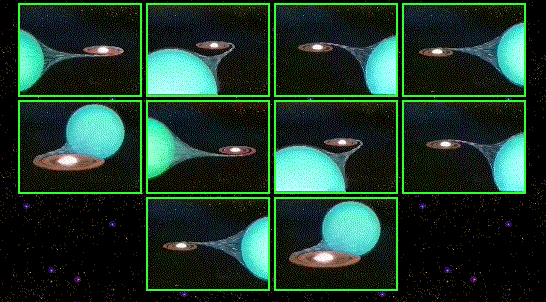
“What does a black hole look like? If alone, a black hole would indeed appear quite black, but many black hole candidates are part of binary star systems. So how does a black hole binary system look different from a neutron star binary system? The above drawings indicate it is difficult to tell! Recent theoretical work, however, has provided a new way to tell them apart: advective accretion flows (ADAFs). A black hole system so equipped would appear much darker than a similar neutron star system. The difference is caused by the hot gas from the ADAF disk falling through the event horizon of the black hole and disappearing - gas that would have emitted much light were the central object only a neutron star. Recent observations of the soft X-ray transient V404 Cyg has yielded a spectrum much like an ADAF onto a black hole - and perhaps brighter than allowable from an ADAF onto a neutron star. "
Copyright: Public domain
#577 Trapezium: Teardrops in My Skies
Credit: January 16, 1997
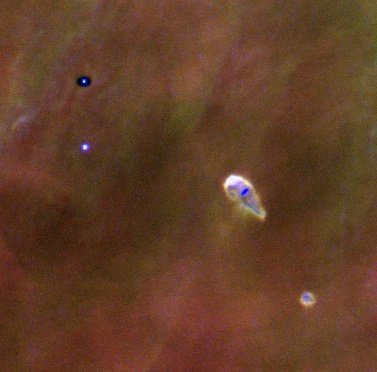
“Sometimes the unexpected comes in a familiar shape. In this recently released picture, the seemingly familiar teardrop-shaped object just right of center is actually an unusually situated disk of gas and dust. In fact, the teardrop is about the size of our own Solar System and is racing against time to condense and form planets. This disk, however, is unfortunate enough to lie in the Trapezium, which is also home to several immense, bright stars. These bright stars emit light so powerful it boils away the gas and dust in planet-forming disks. Large Jupiter-like planets will probably never form in this hostile environment, but it is currently unknown whether Earth-like planets could form and survive. "
Copyright: Public domain
#578 Europa: The Latest From Galileo January 17, 1997
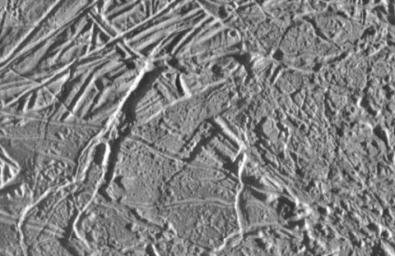
“Today, NASA revealed recent results from the Galileo Probe's December 19th flyby of Europa, Jupiter's ice-covered moon - including this close-up image of fractured and frozen terrrain. The highest resolution picture ever made of Europa, the snapshot shows a complex array of surface features in a 5.9 x 9.9 mile area near the moon's equatorial region. North is toward the top and the Sun illuminates the region from the right. The image was made from a distance of 2,060 miles. At the upper left are linear criss-crossing ridges and grooves probably caused by movements of the surface ice. Serpentine valleys and lumpy features of unknown origins are also visible. Only a few impact craters are apparent though, implying a geologically young surface. So far, Galileo's findings lend support to the exciting possibility that liquid water once existed and may still exist beneath Europa's surface."
Copyright: Public domain
#579 M16: Nebula With Star Cluster January 18, 1997
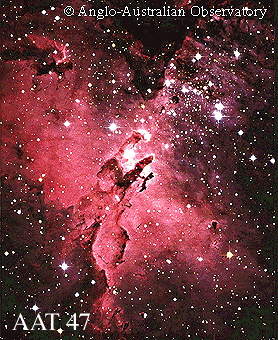
“The photogenic M16 shown above is composed of a young star cluster associated with a spectacular emission nebulae lined with clouds of interstellar dust. The gorgeous spectacle lies toward the galactic center region, some 7,000 light years distant in the constellation Serpens. Most of the stars in the cluster can be seen offset just above and to the right of the photograph's center. This type of star cluster is called an "open" or "galactic" cluster and typically has a few hundred young bright members. The redness of the surrounding emission nebula gas is caused by electrons recombining with hydrogen nuclei, while the dark regions are dust lanes that absorb light from background sources. The dust absorbs so much light it allows astronomers to determine which stars are inside the nebula and which are in the foreground. Stars are forming within the nebula, also known as the Eagle Nebula."
Copyright: Anglo-Australian Telescope
Board
#580 From Eagle's EGGs A Star Is Born January 19, 1997
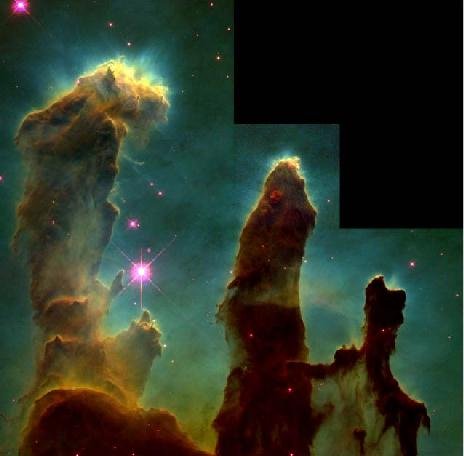
“Perhaps the most famous astronomical image in recent years reveals newborn stars upon pillars of gas and dust - uncovered as researchers used the Hubble Space Telescope to explore the Eagle Nebula in 1995. This stunning picture provides a first hand glimpse of star birth as evaporating gaseous globules (EGGs) are captured emerging from pillars of molecular hydrogen gas and dust. These pillars, dubbed "elephant trunks," are light years in length and are so dense that interior gas gravitationally contracts to form stars. At each pillars' end, the intense radiation of bright young stars causes low density gas to boil away, leaving stellar nurseries of dense EGGs exposed."
Copyright: Public domain
#581 Earth Nears Asteroid Toutatis January 20, 1997
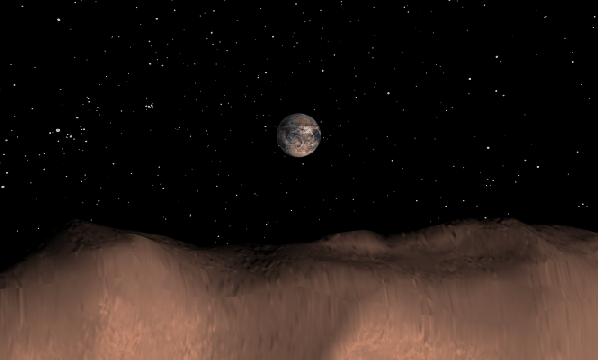
“On November 29, 1996 the Earth came within 3.3 million miles of the asteroid Toutatis. Above is a computer simulated picture of this spectacle from the surface of Toutatis (a 2.5 degree field of view looking toward Earth). In Earth's sky, Toutatis appeared only as a faint object moving against a background of stars. Also known as Earth-crossing asteroid 4179, Toutatis is in an eccentric 4 year orbit which moves it from the asteroid belt between Mars and Jupiter to just inside Earth's orbit. When the Earth passed near it in 1992 Toutatis was imaged by radar and seen to be two irregularly shaped lumps, perhaps joined by a narrow neck. This bizarre object is up to 1.5 miles wide, 2.9 miles long, and is tumbling through space. In the year 2004, on September 29, the Earth will pass very near Toutatis, closing to within a million miles (4 times the Earth-Moon distance) - the closest approach predicted for any asteroid or comet between now and 2060. Studies of Toutatis and other Earth-crossing asteroids help reveal connections between the Solar System's meteorites,main-belt asteroids and comets. These wayward asteroids also offer tantalizing targets for robotic exploration and, over time, represent potential collision hazards for planet Earth!"
Copyright: Public domain
#582 Journey to the Center of the Galaxy
Credit: January 21, 1997
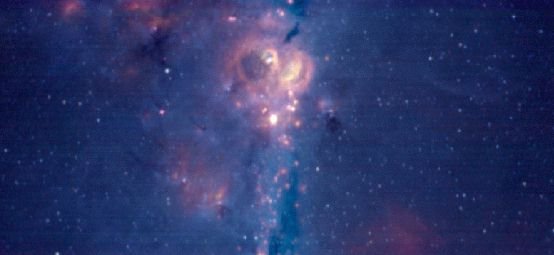
“In Jules Verne's science fiction classic A Journey to the Center of the Earth, Professor Hardwigg and his fellow explorers encounter many strange and exciting wonders. What wonders lie at the center of our Galaxy? Astronomers now know of some of the bizarre objects which exist there, like vast dust clouds, bright young stars, swirling rings of gas, and possibly even a large black hole. Much of the Galactic center region is shielded from our view in visible light by the intervening dust and gas. But it can be explored using other forms of electromagnetic radiation, like radio, infrared, X-rays, and gamma rays. This beautiful high resolution image of the Galactic center region in infrared light was made by the SPIRIT III telescope onboard the Midcourse Space Experiment. The center itself appears as a bright spot near the middle of the roughly 1x3 degree field of view, the plane of the Galaxy is vertical, and the north galactic pole is towards the right. The picture is in false color - starlight appears blue while dust is greenish grey, tending to red in the cooler areas."
Copyright: Public domain
#583 Galaxy Cluster A2199
Credit: January 22, 1997
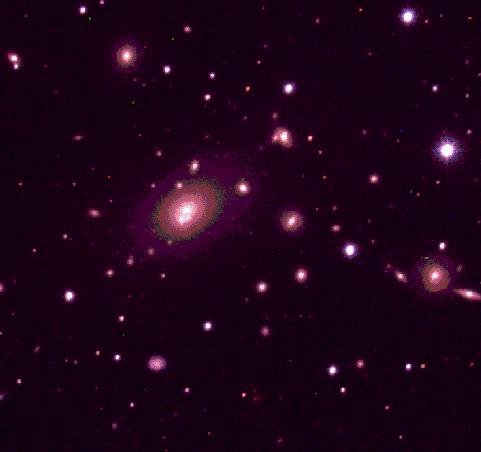
“It's bigger than a bread box. In fact, it's much bigger than all bread boxes put together. Abell 2199 is huge. In fact, it is a close, large cluster of galaxies, containing several thousands of galaxies centered around a central dominant galaxy. "Close," however, is only relative to other clusters of galaxies, since light takes about 50 million years to reach us from A2199. All of the fuzzy objects in the above picture are galaxies, but these galaxies do not contain most of the matter in the cluster. By studying clusters like A2199, astronomers conclude that some form of dark matter dominates the motion of the bright galaxies. What, exactly, this dark matter is poses one of the greatest astronomical puzzles of modern times. "
Copyright: Public domain
#584 Twistin' by the Lagoon January 23, 1997
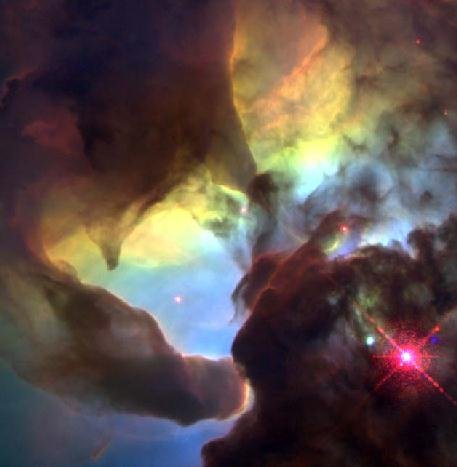
“The awesome spectacle of starbirth produces extreme stellar winds and intense energetic starlight -- bombarding dusty molecular clouds inside the Lagoon Nebula (M8). At least two long funnel shaped clouds, each roughly half a light-year long, have apparently been formed by this activity. They extend from the upper left of this close-up of the bright area of the Lagoon known as 'the Hour Glass'. Are these interstellar funnel clouds actually swirling, twisting analogs to Earthly tornados? It's possible. As energy from nearby young hot stars, like the one at lower right, pours into the cool dust and gas, large temperature differences in adjoining regions can be created generating shearing winds. Confirmation of tornado-like motions within the Lagoon's stellar nursery could come from new instruments scheduled to be installed on the Hubble Space Telescope (HST) during February's servicing mission. This picture is a recently reprocessed HST image made in 1995 as researchers explored this nearby (5,000 light-year distant) starforming region which lies in the direction of Sagittarius."
Copyright: Public domain
Upvote! Resteem! Comment! As you like it! Thank you for attention!